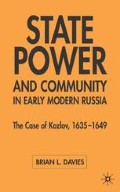Abstract
Imagine a great arc running across the map of Ukraine and Russia, moving northeast from the Romanian border through Zhitomir, Kiev, Orel, Tula, Riazan’, and Simbirsk and ending at Ufa near the Urals. Below this line, stretching as far south as the shores of the Black Sea and the Caspian and the foothills of the Caucasus, spread 270 million acres of humus-rich black soil called chernozem. Although this region is vulnerable to occasional drought, its black soil is so much more fertile than the leached gray soil (podzol’) of northern Russia that by the middle of the eighteenth century its agriculture was already half again as productive with the same labor inputs as agriculture in the northern grey soil zone.1
Access this chapter
Tax calculation will be finalised at checkout
Purchases are for personal use only
Preview
Unable to display preview. Download preview PDF.
Notes
A. V. Dulov, Geograficheskaia sreda i istoriia Rossii, konets XV-seredina XIX v. (Moscow: Nauka, 1983), pp. 58–59; R. A. French, “Introduction,” Studies in2 Enlistment and the construction of social identity
R. A. French, “Introduction,” Studies in Russian Historical Geography. Volume One ,eds J. H. Bater and R. A. French (London: Academic Press, 1983), p. 16.
William H. McNeill, Europe’s Steppe Frontier, 1500–1800 (Chicago: University of Chicago, 1964), pp. 4–6; Shaw, “Southern Frontiers,” pp. 120–121.
M. N. Tikhomirov, Rossiia v XVI stoletii ( Moscow: AN SSSR, 1962 ), pp. 423–424.
R. G. Skrynnikov, Tsarstvo terrora ( St Petersburg: Nauka, 1992 ), p. 427.
V. A. Serchik, “Rech’ Pospolita i kazachestvo v pervoi chetverti XVII v.,” Rossiia, Pol’sha i Prichernomor’e v XV–XVIII vv., ed. B. A. Rybakov (Moscow: Nauka, 1979), pp. 174–196; Sysyn, “Ukrainian Social Tensions,” pp. 66–68.
I. Beliaev, “O storozhevoi, stanichnoi, i polevoi sluzhby na pol’skoi okraine Moskovskago gosudarstva do tsaria Alekseiia Mikhailovicha,” ChOIDR 4 (1846), pp. 40, 45–46.
P. N. Chermenskii, Ocherki po istorii kolonizatsii tambovskago kraia (Tambov, 1911 ), pp. 9, 66.
V. V. Dokuchaev, Russian Chernozem, trans. N. Kaner (Jerusalem: Israel Program for Scientific Translations, 1967), pp. 215–217, 228, 231; SNM, pp. xv–xvi.
P. I. Piskarev, Sobranie materialov dlia istorii zapadnago kraia Tambovskoi gubernii i eparkhii (Tambov, 1878 ), p. 2.
Carol B. Stevens, Soldiers on the Steppe: Army Reform and Social Change in Early Modern Russia ( De Kalb: Northern Illinois University, 1995 ), p. 37.
M. K. Liubavskii, Obzor istorii russkoi kolonizatsii ( Moscow: Moskovskii universitet, 1996 ), p. 304.
Copyright information
© 2004 Brian L. Davies
About this chapter
Cite this chapter
Davies, B.L. (2004). Kozlov and the Pacification of the Nogai Front. In: State Power and Community in Early Modern Russia. Palgrave Macmillan, London. https://doi.org/10.1057/9780230000643_2
Download citation
DOI: https://doi.org/10.1057/9780230000643_2
Publisher Name: Palgrave Macmillan, London
Print ISBN: 978-1-349-51575-2
Online ISBN: 978-0-230-00064-3
eBook Packages: Palgrave History CollectionHistory (R0)

